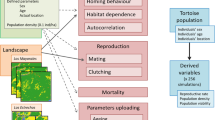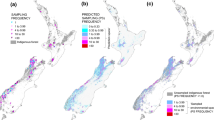Abstract
Theory predicts that due to their resilience, ecosystems and populations are expected to respond to environmental changes not gradually, but in a nonlinear way with sudden abrupt shifts. However, it is not easy to observe and predict the state-and-transition dynamics in the real world because of time lags between exogenous perturbations and species response. Based on yearly surveys, during 21 years (1994–2014), we have studied population dynamics of a desert rodent (the midday gerbil, Meriones meridianus) in the rangelands of southern Russia under landscape change from desert to steppe caused by the drastic reduction of livestock after the collapse of the USSR in the early 1990s. The population of M. meridianus has remained robust to landscape change from desert to steppe for over 10 years, but then has suddenly dropped down and has not recovered since. The step transition from the high- to low-abundance density-regulated equilibrium was accompanied by an abrupt increase in the spatio-temporal population variability, which may indicate the loss of population resilience. We explain inertia in species response to landscape change and an abrupt regime shift in population dynamics by species-specific ecology and life-history combined with habitat fragmentation that had reached a certain critical threshold level by the early 2000s. This is a rare well-documented demonstration of a delayed threshold response of a wild unexploited mammal population to human-induced environmental change, which may shed light on the mechanisms of population resilience and underlying causes of threshold population dynamics in a changing world.



Similar content being viewed by others
References
Allee WC, Park O, Emerson AE, Park T, Schmidt KP (1949) Principles of animal ecology. Saunders, Philadelphia
Amarasekare P (1998) Allee effects in metapopulation dynamics. Am Nat 152:298–302
Banks SC, Piggott MP, Stow AJ, Taylor AC (2007) Sex and sociality in a disconnected world: a review of the impacts of habitat fragmentation on animal social interactions. Can J Zool 85:1065–1079. doi:10.1139/Z07-094
Berryman A (1999) Principles of population dynamics and their application. Stanley Thornes, Cheltenham
Berryman A, Lima M (2006) Deciphering the effects of climate on animal populations: diagnostic analysis provides new interpretation of Soay sheep dynamics. Am Nat 168:784–795. doi:10.1086/508670
Bragina EV, Ives AR, Pidgeon AM, Kuemmerle T, Baskin LM, Gubar YP, Piquer-Rodríguez M, Keuler NS, Petrosyan VG, Radeloff VC (2015) Rapid declines of large mammal populations after the collapse of the Soviet Union. Conserv Biol 29:844–853. doi:10.1111/cobi.12450
Carpenter SR, Brock WA (2006) Rising variance: a leading indicator of ecological transition. Ecol Lett 9:311–318. doi:10.1111/j.1461-0248.2005.00877.x
Carpenter SR, Folke C (2006) Ecology for transformation. Trends Ecol Evol 21:309–315. doi:10.1016/j.tree.2006.02.007
Christensen P, Hörnfeldt B (2003) Long-term decline of vole populations in northern Sweden: a test of the destructive sampling hypothesis. J Mammal 84:1292–1299. doi:10.1644/BBa-014
Coulson T, Mace GM, Hudson E, Possingham H (2001) The use and abuse of population viability analysis. Trends Ecol Evol 16:219–221. doi:10.1016/S0169-5347(01)02137-1
Dai L, Vorselen D, Korolev KS, Gore J (2012) Generic indicators for loss of resilience before a tipping point leading to population collapse. Science 336:1175–1177. doi:10.1126/science.1219805
Drake JM, Griffen BD (2010) Early warning signals of extinction in deteriorating environments. Nature 467:456–459. doi:10.1038/nature09389
Dubinin M, Luschekina A, Radeloff V (2011) Climate, livestock, and vegetation: what drives fire increase in the arid ecosystems of Southern Russia? Ecosystems 14:547–562. doi:10.1007/s10021-011-9427-9
Elmqvist T, Folke C, Nyström M, Peterson G, Bengtsson J, Walker B, Norberg J (2003) Response diversity, ecosystem change, and resilience. Front Ecol Environ 1:488–494. doi:10.1890/1540-9295(2003)001[0488:RDECAR]2.0.CO;2
Ewers RM, Didham RK (2006) Confounding factors in the detection of species responses to habitat fragmentation. Biol Rev 8101:117–142. doi:10.1017/S1464793105006949
Forchhammer MC, Stenseth NC, Post E, Landvatn R (1998) Population dynamics of Norwegian red deer: density-dependence and climatic variation. Proc R Soc B 265:341–350. doi:10.1098/rspb.1998.0301
Frank KT, Petrie B, Fisher JA, Leggett WC (2011) Transient dynamics of an altered large marine ecosystem. Nature 477:86–89. doi:10.1038/nature10285
Fraterrigo JM, Rusak JA (2008) Disturbance-driven changes in the variability of ecological patterns and processes. Ecol Lett 11:756–770. doi:10.1111/j.1461-0248.2008.01191.x
Fu H, Wu X, Yang Z, Xu Y (2004) Comparing of niche for rodent species in Alashan desert region of Inner Mongolia. Chin J Zool 39:27–34
Gol’tsman ME, Popov SV, Chabovskiĭ AV, Borisova NG (1994) The sociality syndrome. A comparative study of the behavior of gerbils. Zh Obshch Biol 55:49–69 (in Russian)
Hanski I (1999) Metapopulation ecology. Oxford University Press, New York
Hölzel N, Haub C, Ingelfinger MP, Otte A, Pilipenko VN (2002) The return of the steppe large-scale restoration of degraded land in southern Russia during the post-Soviet era. J Nat Conserv 10:75–85. doi:10.1078/1617-1381-00009
Hörnfeldt B (2004) Long-term decline in numbers of cyclic voles in boreal Sweden: analysis and presentation of hypotheses. Oikos 107:376–392. doi:10.1111/j.0030-1299.2004.13348.x
Ims RA, Henden JA, Killengreen ST (2008) Collapsing population cycles. Trends Ecol Evol 23:79–86. doi:10.1016/j.tree.2007.10.010
Isaev SI, Shilova SA (2000) Biotopic distribution of the midday (Meriones meridianus) and tamarisk (M. tamariscinus) gerbils (Rodentia, Gerbillinae) in the Southern Kalmyk Republic. Izv Akad Nauk Ser Biol 1:94–99 (in Russian)
Liu J, Dietz T, Carpenter SR, Alberti M, Folke C, Moran E, Pell AN, Deadman P, Kratz T, Lubchenco J, Ostrom E, Ouyang Z, Provencher W, Redman CL, Schneider SH, Taylor WW (2007) Complexity of coupled human and natural systems. Science 317:1513–1516. doi:10.1126/science.1144004
Lockwood JA, Lockwood DR (1993) Catastrophe theory: a unified paradigm for rangeland ecosystem dynamics. J Range Manag 46:282–288. doi:10.2307/4002459
Milner-Gulland EJ, Bukreeva OM, Coulson T, Lushchekina AA, Kholodova MV, Bekenov AB, Grachev IA (2003) Conservation: reproductive collapse in saiga antelope harems. Nature 422:135. doi:10.1038/422135a
Mori AS, Furukawa T, Sasaki T (2013) Response diversity determines the resilience of ecosystems to environmental change. Biol Rev 88:349–364. doi:10.1111/brv.12004
Neronov VV, Tchabovskii AV, Aleksandrov DY, Kasatkin MV (1997) Spatial distribution of rodents under conditions of anthropogenic dynamics of vegetation in the South of Kalmykia. Russ J Ecol 28:328–334
Popov NV, Bezsmertny VE, Matrosov AN, Nemchenko LS, Verzhutsky DB, Maletskaya OV, Udovikov AI, Kuznetsov AA, Knyazeva TV, Shilova LD, Gorshenko VV, Popov VP, Toporkov VP, Toporkov AV, Kutyrev VV (2011) Epizootic activity of plague natural foci in the Russian Federation in 2010 and prognosis for 2011. Probl Osobo Opasn Infek 1:1–37 (in Russian)
Rogovin KA (2007) Steppe expansion and changes in the structure of the rodent community in north-western Caspian region (Republic of Kalmykia, RF). Acta Zool Sin 53:29–43
Saiko T, Zonn I (1997) Europe’s first desert. In: Werger MJA, van Staalduinen MA (eds) Eurasian steppes. Ecological problems and livelihoods in a changing world. Springer, Netherlands, pp 141–144
Sasaki T, Okayasu T, Jamsran U, Takeuchi K (2008) Threshold changes in vegetation along a grazing gradient in Mongolian rangelands. J Ecol 96:145–154. doi:10.1111/j.1365-2745.2007.01315.x
Scheffer M, Carpenter S, Foley JA, Folke C, Walker B (2001) Catastrophic shifts in ecosystems. Nature 413:591–596. doi:10.1038/35098000
Shenbrot GI, Krasnov B, Rogovin KA (1999) Spatial ecology of desert rodent communities. Springer, Berlin
Shilova SA, Orlenev DP (2004) Certain behavioral traits of small mammals in abnormal social environment. Biol Bull Russ Acad Sci 31:358–366. doi:10.1023/B:BIBU.0000036940.94275.7f
Shilova SA, Tchabovsky AV (2009) Population response of rodents to control with rodenticides. Curr Zool 55:81–91
Shilova SA, Chabovskiĭ AV, Isaev SI, Neronov VV (2000) Dynamics of rodent community and populations in Kalmyk semideserts under decreasing pasture load and increasing humidity. Izv Akad Nauk Ser Biol 3:332–344 (in Russian)
Shilova SA, Neronov VV, Kasatkin MV, Savinetskaya LE, Tchabovsky AV (2007) Fires at the current stage of evolution of semi-desert in southern Russia: the influence on vegetation and rodent populations. Usp Sovr Biol 127:372–386 (in Russian)
Shilova SA, Savinetskaya LE, Neronov VV (2011) The 28-year abundance and biomass dynamics of the little ground squirrel (Spermophilus pygmaeus Pall., 1778) in the pasture ecosystems of Kalmykia. Arid Ecosyst 1:177–183. doi:10.1134/S2079096111030103
Smelansky IE, Tishkov AA (2012) The steppe biome in Russia: ecosystem services, conservation status, and actual challenges. In: Werger MJA, van Staalduinen MA (eds) Eurasian steppes. Ecological problems and livelihoods in a changing world. Springer, Netherlands, pp 45–101
Suding KN, Hobbs RJ (2008) Threshold models in restoration and conservation: a developing framework. Trends Ecol Evol 24:271–279. doi:10.1016/j.tree.2008.11.012
Swift TL, Hannon SJ (2010) Critical thresholds associated with habitat loss: a review of the concepts, evidence, and applications. Biol Rev 85:35–53. doi:10.1111/j.1469-185X.2009.00093.x
Turchin P (2003) Complex population dynamics: a theoretical/empirical synthesis (MPB-35). Princeton University Press, Princeton
Varshavsky SN, Popov NV, Varshavsky BS, Shilov MN, Tikhomirov EL, Bugakov AA (1991) Modification of the species composition of rodents in the north-western region of the caspian sea area under the effect of anthropogenic factors. Zool Zh 70:92–100 (in Russian)
Vinogradov BV (1995) Forecasting dynamics of deflated sands of Black Lands, Kalmykia using aerial photography. In: Zonn IS, Neronov VM (eds) Biota and environment of Kalmykia. Korkis, Moscow, pp 259–268 (in Russian)
Werger MJA, van Staalduinen MA (2012) Eurasian steppes. Ecological problems and livelihoods in a changing world. Springer, Netherlands
Wiens JA, Hobbs RJ (2015) Integrating conservation and restoration in a changing world. Bioscience 65:302–312. doi:10.1093/biosci/biu235
Acknowledgments
We are grateful to S.A. Shilova who encouraged and supported the study. We thank S.I. Isaev, D.B. Vasiliev, A.B. Savinetsky, A. Mokrousov, D.V. Pozharisky, I.Y. Popov, V.A. Kuznetsov, A.I. Shilov for field work; and G.A. Bazykin, B. Krasnov, V. Alekseev, P.P. Dmitriev and two anonymous reviewers for commenting on previous versions of the manuscript. This work was supported by grants from the Russian Foundation for Basic Research (Grant 13-04-00086; 16-04-00739) and the Program for Fundamental Studies “Biological Resources” of the Russian Academy of Sciences for A.T. (Grant# 1.4.15).
Author contribution statement
A.T., L.S., and N.O. collected and treated the data. A.T., E.S and I.K. performed the analysis. A.T. and E.S. wrote the paper. All authors contributed substantially to revisions of the draft paper.
Author information
Authors and Affiliations
Corresponding author
Ethics declarations
Conflict of interest
The authors declare that they have no conflict of interest.
Ethical approval
All applicable institutional and/or national guidelines for the care and use of animals were followed.
Additional information
Communicated by Hannu J. Ylonen.
Rights and permissions
About this article
Cite this article
Tchabovsky, A.V., Savinetskaya, L.E., Surkova, E.N. et al. Delayed threshold response of a rodent population to human-induced landscape change. Oecologia 182, 1075–1082 (2016). https://doi.org/10.1007/s00442-016-3736-9
Received:
Accepted:
Published:
Issue Date:
DOI: https://doi.org/10.1007/s00442-016-3736-9




